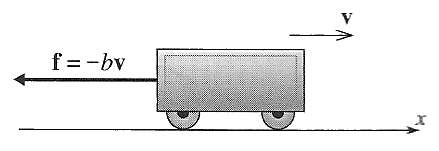Linear resistance [2.2, 2.3]
Preparation: read also this material on [Separation of variables. Here is even more content including the justification for separation of variables (Calc I)]. Be able to solve and sketch solutions to differential equations like this one
$$\frac{d}{dt}f(t) = k f(t).$$
Where $k$ is a constant, and might be positive or negative. (See problem 1.24). What function of time $f(t)$
is the solution?
Linear resistance
 We can neglect the quadratic contribution to air resistance at low Reynolds number, when speeds are slow, and/or viscosity is high.
$$\myv{f}(v) \approx -bv \uv{v}$$
We can neglect the quadratic contribution to air resistance at low Reynolds number, when speeds are slow, and/or viscosity is high.
$$\myv{f}(v) \approx -bv \uv{v}$$
The equation of motion for our particle is then
$$m \ddot{\myv{r}} = m \myv{g} - b \myv{v}$$
Since $\dot{\myv{r}}=\myv{v}$, we can turn this into a differential equation for velocity:
$$m \dot{\myv{v}} = m \myv{g} -b \myv{v}$$
We can write two scalar differential equations, one for the horizontal ($x$) component of $\myv v$, and one for the vertical ($y$) component. Following Taylor's convention, we'll say that "down" is the positive $y$-direction:
$$ m \dot{v}_x = -bv_x$$
$$ m \dot{v}_y = mg -b v_y$$
Each of these is a first order differential equation which can be separated in Cartesian coordinates, and then integrated.
Horizontal motion
 The $x$ equation alone might describe a cart (with no rolling resistance!) moving over a flat surface, through a viscous medium.
$$ \dot{v}_x = -\frac{b}{m} v_x$$
The $x$ equation alone might describe a cart (with no rolling resistance!) moving over a flat surface, through a viscous medium.
$$ \dot{v}_x = -\frac{b}{m} v_x$$
The exponential function has the property that its derivative is identical to itself,
to within a constant of multiplication, and so the solution is:
$$v_x(t)= A e^{-t b/m}=v_x(0)e^{-t/\tau}; \ \ \tau=m/b$$
As an example, below is a graph of $v_x(t)=10e^{-t/4.5}$; $10/e=3.68$)
 We can neglect the quadratic contribution to air resistance at low Reynolds number, when speeds are slow, and/or viscosity is high.
$$\myv{f}(v) \approx -bv \uv{v}$$
We can neglect the quadratic contribution to air resistance at low Reynolds number, when speeds are slow, and/or viscosity is high.
$$\myv{f}(v) \approx -bv \uv{v}$$
 The $x$ equation alone might describe a cart (with no rolling resistance!) moving over a flat surface, through a viscous medium.
$$ \dot{v}_x = -\frac{b}{m} v_x$$
The $x$ equation alone might describe a cart (with no rolling resistance!) moving over a flat surface, through a viscous medium.
$$ \dot{v}_x = -\frac{b}{m} v_x$$